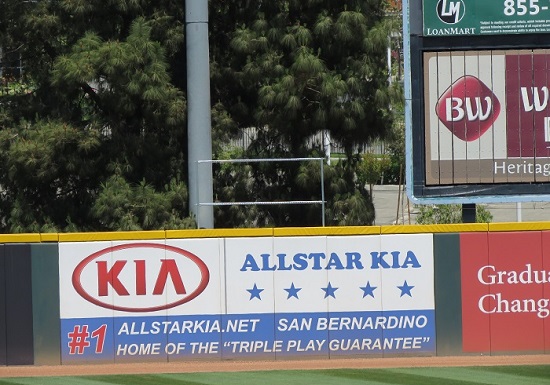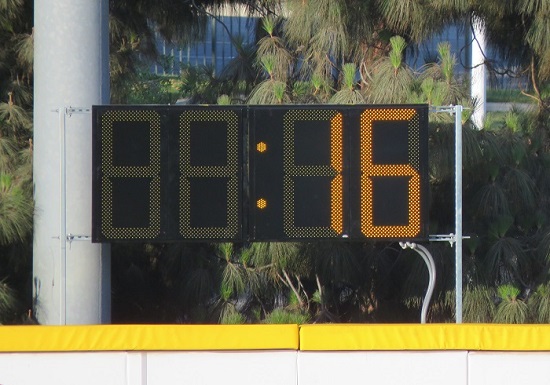A few months before the start of the 2021 Minor League Baseball season, some changes were announced that would take place in different leagues and divisions. Within the Low A West, home of the Dodgers affiliated Rancho Cucamonga Quakes, two big changes were slated to come into play.
The first change affected all of Low A ball and involves pick-off attempts:
“A pitcher is allowed to make two pick-off attempts per plate appearance with at least one runner on base. A third, unsuccessful attempt, will allow the runner(s) to advance to the next base and will be scored as a balk.”
This has, so far, resulted in more stolen base attempts, which is exciting for fans and a good boost for player stats. It could eventually be reduced to just one attempt, which would appeal even more to fans who despise the seemingly never-ending pick-off attempts that seem to occur in most MLB games.
However, the real news here is the second change, brought only to the Low A West division – a countdown timer clock. AA and AAA have had pitch clocks and between-inning timers for a few years now, but it was only recently introduced, in a limited capacity, to the lower levels of the sport.
Starting June 1, the Low A West league put up and turned on their countdown clocks at each of their ballparks that will be used for pitching/at-bats, mound visits, and in-between innings in hopes of increasing the pace of play.


In its first week, fans and players got the chance to see the clocks in action and get used to their bright orange presence, both in center field and behind each on-deck circle. On June 8, the clocks became official, and penalties could be dealt out for time expiration.
There are a few different time settings depending on the situation, with the first being a 15-second countdown for the pitcher when there are no baserunners. Once they receive the ball from the catcher, the timer begins.
With base runner(s), the timer is upped to 17 seconds to give the pitcher a chance to check on the runner(s) before preparing to throw home.
Now for the interesting part – the penalties for violation of the timer rules:
If the pitcher has not begun their delivery by :00, the batter will be awarded a ball. However, if the hitter is not “ready,” making eye contact, by the :08 second mark, a strike is added to the count.
“We’ve seen it twice in the [Lake Elsinore] series so far,” said Quakes Director of Public Relations and longtime play-by-play broadcaster (on Newstalk 1290) Mike Lindskog. “(Quakes right-hander) Carlos Duarte was charged with a ball on Tuesday in the first inning at-bat against Brandon Valenzuela; I believe it made the count 1-1. The other time was last night [June 9th], when (Quakes infielder) Brandon Lewis was at the plate for Rancho and, on 3-2, the pitcher ran out of time. Lewis went to first base to load the bases. It was wild that it impacted the game like that. Very strange. It made for an intense moment.”
The penalty pitch was officially scored as an ‘Automatic Ball’ to differentiate it and led to an intentional walk scoring for Lewis.
Additionally, the clock seems to start at 30 seconds for the start of an at-bat as well as for mound visits. They also run the clock in between innings to discourage lolly-gagging.
Not only has the pitch clock and its penalties essentially made the game more exciting, but it has also helped with game speed … for the most part.
On average, a fan can assume a standard, nine-inning baseball game will be about three hours long. Of course, that can vary if there’s a pitcher’s duel or if the players are having their own unofficial Home Run Derby. But for the most part, about three hours is standard. Since the introduction of the pitch clock, average game times for the Quakes are closer to the two-and-a-half-hour mark. This might not sound like much, but it can make quite a difference getting home a half-hour earlier.
Combined with the Quakes new 6:30 p.m. start times, the games are now ending around 9 p.m. instead of 10 p.m. This allows fans to get home earlier still being able to squeeze in a ball game. It’s a best-of-both-worlds situation for avid MiLB fans.
Of all the ‘interesting’ and even questionable things MLB Commissioner Rob Manfred has done for the game of baseball, this is one that fans might actually get behind.
* * * * * *




 June 14th, 2021 at 9:00 am
June 14th, 2021 at 9:00 am  by Lauren Jennings
by Lauren Jennings  Posted in
Posted in 

Most Dodger home night games start at 10:10 PM ET so I’d like anything that would shorten the length of the game and get me to bed earlier.
That ruling looks great to me.